|
|
St Mary's Loch
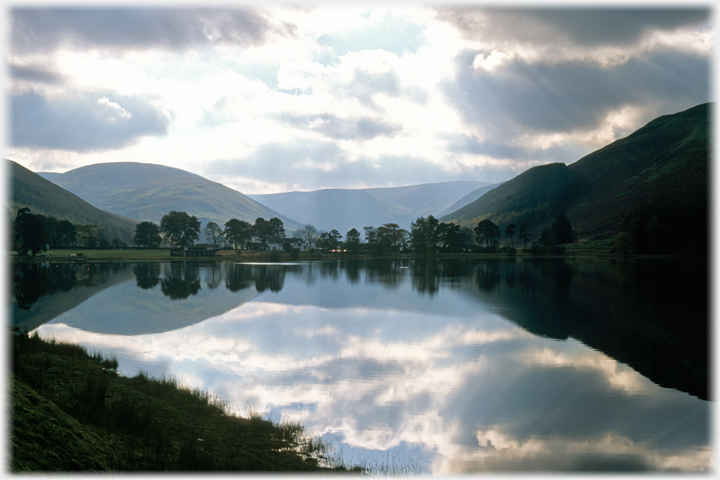 The silhouetted trees stand on an isthmus at the south end of St Mary's Loch; the building among them is Tibbie Shiels Inn
In the upper part of Yarrow Water lie two lochs separated by a narrow isthmus of land on which sits the famous inn named after its first proprietress - Tibbie Shiels. Its reputation was made by the fact that Sir Walter Scott and James Hogg (The Ettrick Shepherd) used to meet here and go fishing on the Loch. St Mary's is much the larger of the two stretches of water, being about 3 miles in length, and is still used for fishing, and also houses a sailing club. It is some 250 metres (800 feet) above sea level, the winters are long, and some 50 inches of rain falls in a year.
The silhouetted trees stand on an isthmus at the south end of St Mary's Loch; the building among them is Tibbie Shiels Inn
In the upper part of Yarrow Water lie two lochs separated by a narrow isthmus of land on which sits the famous inn named after its first proprietress - Tibbie Shiels. Its reputation was made by the fact that Sir Walter Scott and James Hogg (The Ettrick Shepherd) used to meet here and go fishing on the Loch. St Mary's is much the larger of the two stretches of water, being about 3 miles in length, and is still used for fishing, and also houses a sailing club. It is some 250 metres (800 feet) above sea level, the winters are long, and some 50 inches of rain falls in a year.
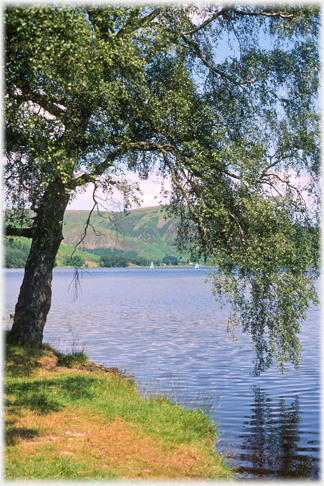 A birch dips its toes into the loch
A birch dips its toes into the loch
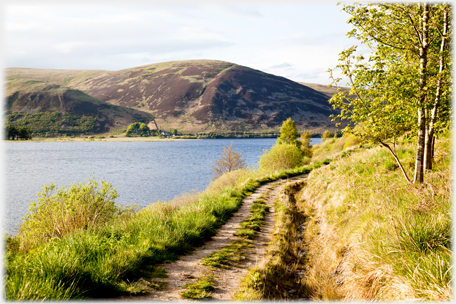 On the side of the Loch that is away from the road, a wide easy track takes the walker from Tibbie Shiels at the south end of the loch back to the road at the northern end
On the side of the Loch that is away from the road, a wide easy track takes the walker from Tibbie Shiels at the south end of the loch back to the road at the northern end
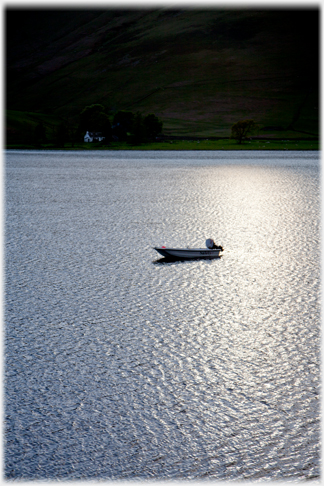 A boat in the evening light
A boat in the evening light
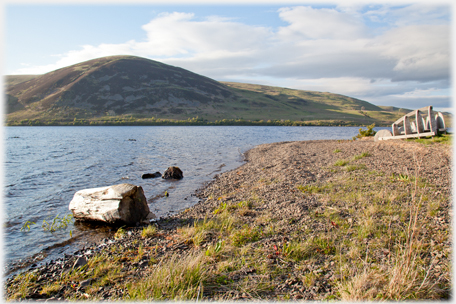 Here the background is supplied by Capper Law. Along the walkers' way a series of labels and sculptures have been placed, which some find slightly tawdry by comparison with the scenery...
Here the background is supplied by Capper Law. Along the walkers' way a series of labels and sculptures have been placed, which some find slightly tawdry by comparison with the scenery...
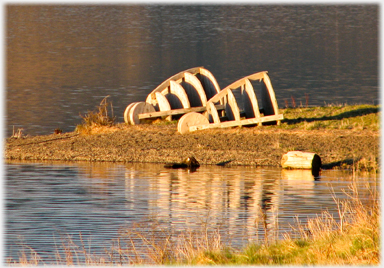 ...from which they seem to be trying to distract. They will soon become inconsequential lichen covered shapes
...from which they seem to be trying to distract. They will soon become inconsequential lichen covered shapes
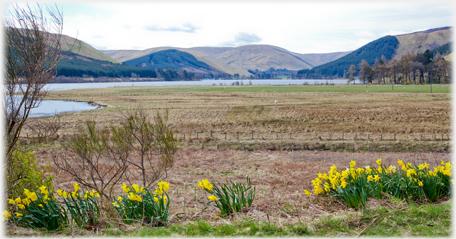 The sharp contrast of the bright daffodils in April at Cappercleuch against the greyed-out colours of a pre-spring landscape
The sharp contrast of the bright daffodils in April at Cappercleuch against the greyed-out colours of a pre-spring landscape
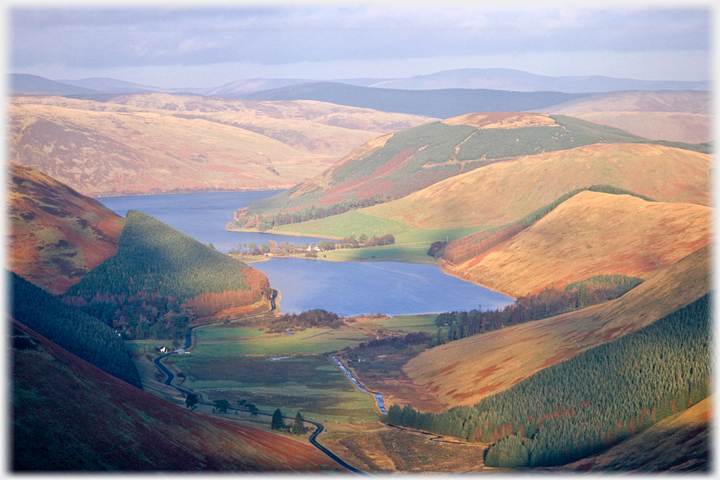 The view into the upper Yarrow Valley with the Loch of the Lowes in the foreground, and St Mary's Loch beyond, separated by the isthmus on which sits Tibbie Shiels Inn. The picture was taken from Herman Law the hill that marks the boundary between Dumfriesshire and The Borders
The view into the upper Yarrow Valley with the Loch of the Lowes in the foreground, and St Mary's Loch beyond, separated by the isthmus on which sits Tibbie Shiels Inn. The picture was taken from Herman Law the hill that marks the boundary between Dumfriesshire and The Borders
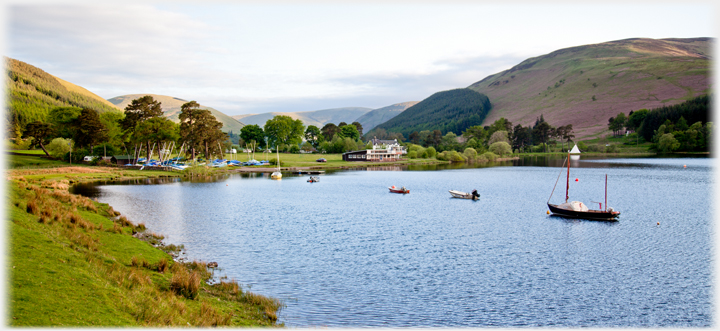 The south end of the Loch with the sailing club and Tibbie Shiels Inn
The south end of the Loch with the sailing club and Tibbie Shiels Inn
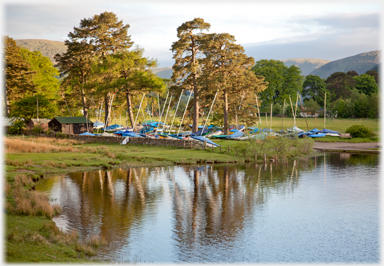 Come the autumn, St Mary's Sailing Club beach their dinghies for the winter period
Come the autumn, St Mary's Sailing Club beach their dinghies for the winter period
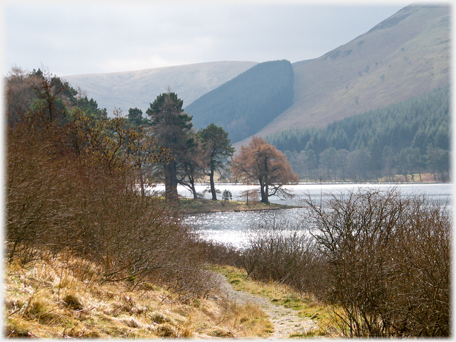 March Wood from the north side
March Wood from the north side
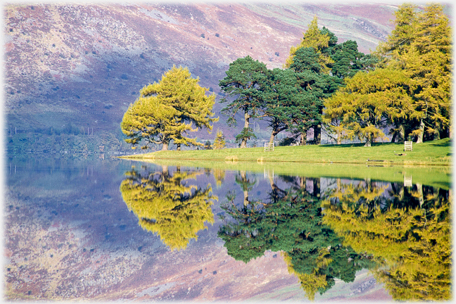 Autumn in full swing at March Wood with the Japanese Larch leading the way. This small area of older trees, on the west bank of the Loch, is now part of a Community Woodland and more trees are being planted
Autumn in full swing at March Wood with the Japanese Larch leading the way. This small area of older trees, on the west bank of the Loch, is now part of a Community Woodland and more trees are being planted
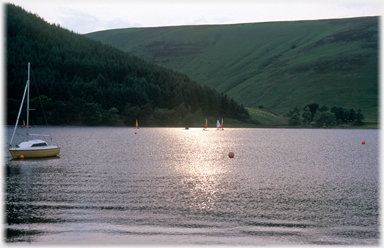 Boats on the Loch in the late evening
Megget Water and Kirkstead Burn are the two chief contributors to the Loch, flowing out of it is Yarrow Water taking its name from the valley in which it lies, and made famous in
Wordsworth's poem "Yarrow Revisited".
Boats on the Loch in the late evening
Megget Water and Kirkstead Burn are the two chief contributors to the Loch, flowing out of it is Yarrow Water taking its name from the valley in which it lies, and made famous in
Wordsworth's poem "Yarrow Revisited".

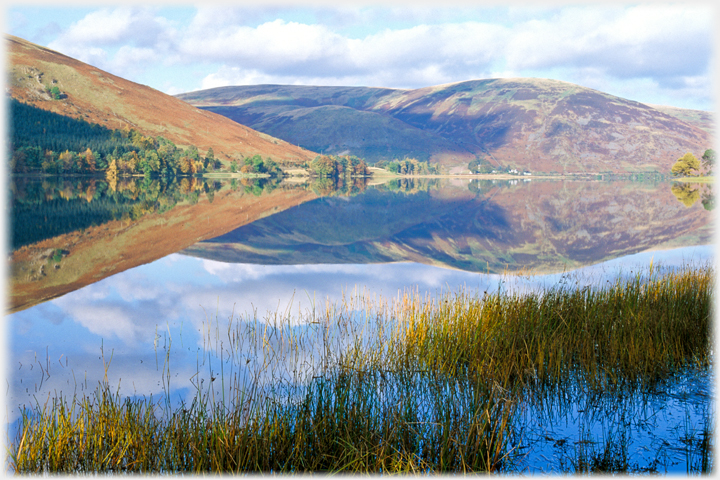 Reeds at the end of the Loch
Reeds at the end of the Loch
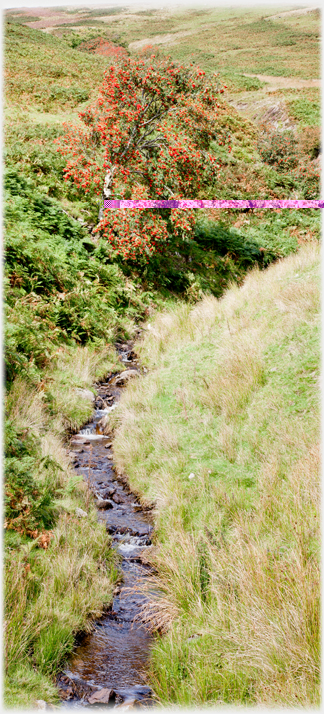 A rowan finds shelter by a burn just below the kirkyard
A rowan finds shelter by a burn just below the kirkyard
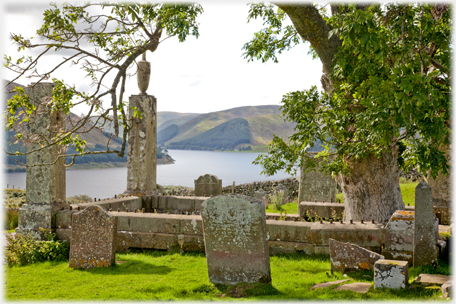 Hiding in a fold of the hills, just above the Loch, is St Mary's Kirkyard. The photo above looks up the Loch to Watch Hill. The first record of a religious establishment on this site was in 1275 when money was collected for the Crusades, and it seems that a kirk had been erected by 1292, this was abandoned in 1640, but the burial ground remained in use until the early 19th century
Hiding in a fold of the hills, just above the Loch, is St Mary's Kirkyard. The photo above looks up the Loch to Watch Hill. The first record of a religious establishment on this site was in 1275 when money was collected for the Crusades, and it seems that a kirk had been erected by 1292, this was abandoned in 1640, but the burial ground remained in use until the early 19th century
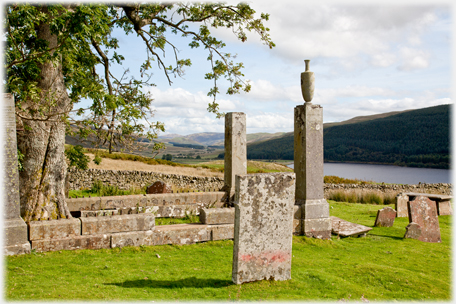 The kirkyard looking downstream to the north, and towards the onetime county town of Selkirk
The kirkyard looking downstream to the north, and towards the onetime county town of Selkirk
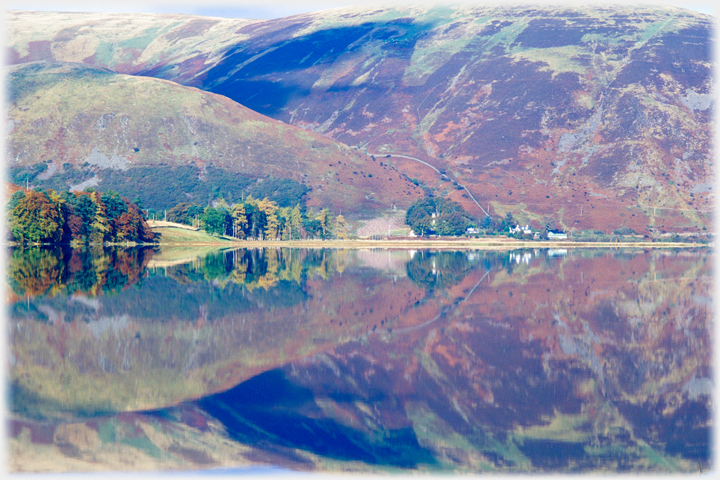 A still autumn morning with Henderland Bank reflected in the waters of the Loch
The next page
goes to the second of this duo of waters - The Loch of the Lowes - and the joining isthmus on which sits Tibbie Shiels Inn. Also sitting (and overlooking the Inn) is a statue of James Hogg - the Ettrick Shepherd.
A still autumn morning with Henderland Bank reflected in the waters of the Loch
The next page
goes to the second of this duo of waters - The Loch of the Lowes - and the joining isthmus on which sits Tibbie Shiels Inn. Also sitting (and overlooking the Inn) is a statue of James Hogg - the Ettrick Shepherd.
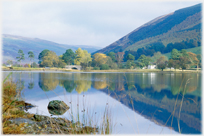

Saturday 22nd July 2017

Go to the Picture Posting contents page
Return to the top
|
|
 The silhouetted trees stand on an isthmus at the south end of St Mary's Loch; the building among them is Tibbie Shiels Inn
In the upper part of Yarrow Water lie two lochs separated by a narrow isthmus of land on which sits the famous inn named after its first proprietress - Tibbie Shiels. Its reputation was made by the fact that Sir Walter Scott and James Hogg (The Ettrick Shepherd) used to meet here and go fishing on the Loch. St Mary's is much the larger of the two stretches of water, being about 3 miles in length, and is still used for fishing, and also houses a sailing club. It is some 250 metres (800 feet) above sea level, the winters are long, and some 50 inches of rain falls in a year.
The silhouetted trees stand on an isthmus at the south end of St Mary's Loch; the building among them is Tibbie Shiels Inn
In the upper part of Yarrow Water lie two lochs separated by a narrow isthmus of land on which sits the famous inn named after its first proprietress - Tibbie Shiels. Its reputation was made by the fact that Sir Walter Scott and James Hogg (The Ettrick Shepherd) used to meet here and go fishing on the Loch. St Mary's is much the larger of the two stretches of water, being about 3 miles in length, and is still used for fishing, and also houses a sailing club. It is some 250 metres (800 feet) above sea level, the winters are long, and some 50 inches of rain falls in a year.
 A birch dips its toes into the loch
A birch dips its toes into the loch
 On the side of the Loch that is away from the road, a wide easy track takes the walker from Tibbie Shiels at the south end of the loch back to the road at the northern end
On the side of the Loch that is away from the road, a wide easy track takes the walker from Tibbie Shiels at the south end of the loch back to the road at the northern end
 A boat in the evening light
A boat in the evening light
 Here the background is supplied by Capper Law. Along the walkers' way a series of labels and sculptures have been placed, which some find slightly tawdry by comparison with the scenery...
Here the background is supplied by Capper Law. Along the walkers' way a series of labels and sculptures have been placed, which some find slightly tawdry by comparison with the scenery...
 ...from which they seem to be trying to distract. They will soon become inconsequential lichen covered shapes
...from which they seem to be trying to distract. They will soon become inconsequential lichen covered shapes
 The sharp contrast of the bright daffodils in April at Cappercleuch against the greyed-out colours of a pre-spring landscape
The sharp contrast of the bright daffodils in April at Cappercleuch against the greyed-out colours of a pre-spring landscape
 The view into the upper Yarrow Valley with the Loch of the Lowes in the foreground, and St Mary's Loch beyond, separated by the isthmus on which sits Tibbie Shiels Inn. The picture was taken from Herman Law the hill that marks the boundary between Dumfriesshire and The Borders
The view into the upper Yarrow Valley with the Loch of the Lowes in the foreground, and St Mary's Loch beyond, separated by the isthmus on which sits Tibbie Shiels Inn. The picture was taken from Herman Law the hill that marks the boundary between Dumfriesshire and The Borders
 The south end of the Loch with the sailing club and Tibbie Shiels Inn
The south end of the Loch with the sailing club and Tibbie Shiels Inn
 Come the autumn, St Mary's Sailing Club beach their dinghies for the winter period
Come the autumn, St Mary's Sailing Club beach their dinghies for the winter period
 March Wood from the north side
March Wood from the north side
 Autumn in full swing at March Wood with the Japanese Larch leading the way. This small area of older trees, on the west bank of the Loch, is now part of a Community Woodland and more trees are being planted
Autumn in full swing at March Wood with the Japanese Larch leading the way. This small area of older trees, on the west bank of the Loch, is now part of a Community Woodland and more trees are being planted
 Boats on the Loch in the late evening
Megget Water and Kirkstead Burn are the two chief contributors to the Loch, flowing out of it is Yarrow Water taking its name from the valley in which it lies, and made famous in
Wordsworth's poem "Yarrow Revisited".
Boats on the Loch in the late evening
Megget Water and Kirkstead Burn are the two chief contributors to the Loch, flowing out of it is Yarrow Water taking its name from the valley in which it lies, and made famous in
Wordsworth's poem "Yarrow Revisited".

 Reeds at the end of the Loch
Reeds at the end of the Loch
 A rowan finds shelter by a burn just below the kirkyard
A rowan finds shelter by a burn just below the kirkyard
 Hiding in a fold of the hills, just above the Loch, is St Mary's Kirkyard. The photo above looks up the Loch to Watch Hill. The first record of a religious establishment on this site was in 1275 when money was collected for the Crusades, and it seems that a kirk had been erected by 1292, this was abandoned in 1640, but the burial ground remained in use until the early 19th century
Hiding in a fold of the hills, just above the Loch, is St Mary's Kirkyard. The photo above looks up the Loch to Watch Hill. The first record of a religious establishment on this site was in 1275 when money was collected for the Crusades, and it seems that a kirk had been erected by 1292, this was abandoned in 1640, but the burial ground remained in use until the early 19th century
 The kirkyard looking downstream to the north, and towards the onetime county town of Selkirk
The kirkyard looking downstream to the north, and towards the onetime county town of Selkirk
 A still autumn morning with Henderland Bank reflected in the waters of the Loch
The next page
goes to the second of this duo of waters - The Loch of the Lowes - and the joining isthmus on which sits Tibbie Shiels Inn. Also sitting (and overlooking the Inn) is a statue of James Hogg - the Ettrick Shepherd.
A still autumn morning with Henderland Bank reflected in the waters of the Loch
The next page
goes to the second of this duo of waters - The Loch of the Lowes - and the joining isthmus on which sits Tibbie Shiels Inn. Also sitting (and overlooking the Inn) is a statue of James Hogg - the Ettrick Shepherd.


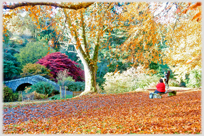 The last page was about Dawyck Botanic Gardens
The last page was about Dawyck Botanic Gardens
 There can also be peace in the city, contemplation beside Hoàn Kiếm Lake in Hà Nội
There can also be peace in the city, contemplation beside Hoàn Kiếm Lake in Hà Nội
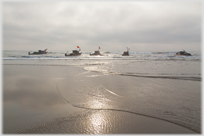 Very different boats on very different water - fishing boats near Tĩnh Gia in Vietnam
Very different boats on very different water - fishing boats near Tĩnh Gia in Vietnam
